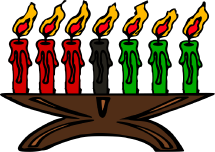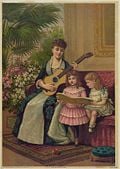Kwanzaa
| Kwanzaa | |
|---|---|

| |
| Seven candles in a kinara symbolize the seven principles of Kwanzaa | |
| Observed by | African Americans, parts of African diaspora |
| Type | Cultural and ethnic |
| Significance | Celebrates African heritage, unity, and culture. |
| Date | December 26 to January 1 |
| Celebrations | Unity Creativity Faith Giving gifts |
| Related to | Pan-Africanism |
Kwanzaa is a week-long annual celebration held in the United States and other nations of the African diaspora to honor African heritage in African-American culture. It is observed from December 26 to January 1, culminating in gift-giving and a feast. In English, the proper greeting is "Joyous Kwanzaa."
Kwanzaa was created by Maulana Karenga and was first celebrated in 1966–1967. The celebration has seven core principles (Nguzo Saba), representing African values which particularly focus on community and working together to create a society of beauty and prosperity shared by all.
History
American Black Power activist and secular humanist Maulana Karenga, also known as Ronald McKinley Everett, created Kwanzaa in 1966, as a specifically African-American holiday.[1] Kwanzaa was established to help African Americans reconnect with their African cultural and historical heritage by uniting in meditation and study of African traditions and Nguzo Saba, the "seven principles of African Heritage," which Karenga said "is a communitarian African philosophy."[2] For Karenga, the creation of such a holiday also underscored the essential premise: "you must have a cultural revolution before the violent revolution. The cultural revolution gives identity, purpose and direction."[3]
The name Kwanzaa derives from the Swahili phrase matunda ya kwanza, meaning "first fruits of the harvest."[4] A more conventional translation would simply be "first fruits."
The choice of Swahili, an East African language, reflects its status as a symbol of Pan-Africanism, especially in the 1960s, although most of the Atlantic slave trade that brought African people to America originated in West Africa.[5][6]
First fruits festivals exist in Southern Africa, celebrated in December/January with the southern solstice, and Karenga was partly inspired by an account he read of the Zulu festival Umkhosi Wokweshwama. It was decided to spell the holiday's name with an additional "a" so that it would have a symbolic seven letters.[3]
During the early years of Kwanzaa, Karenga said it was meant to be an alternative to Christmas. He believed Jesus was psychotic and Christianity was a "White" religion that Black people should shun.[7] As Kwanzaa gained mainstream adherents, Karenga altered his position so practicing Christians would not be alienated: "Kwanzaa was not created to give people an alternative to their own religion or religious holiday."[2] Many African Americans who celebrate Kwanzaa do so in addition to observing Christmas.[8]
Principles and symbols
Kwanzaa celebrates the seven principles of Kwanzaa, or Nguzo Saba (originally Nguzu Saba – the seven principles of African Heritage), which Karenga said "is a communitarian African philosophy," consisting of "the best of African thought and practice in constant exchange with the world."[2] They were developed in 1965, a year before Kwanzaa itself. These seven principles comprise Kawaida, a Swahili word meaning "common."
Each of the seven days of Kwanzaa is dedicated to one of the following principles:[2]
- Umoja (Unity): To strive for and to maintain unity in the family, community, nation, and race.
- Kujichagulia (Self-Determination): To define and name ourselves, as well as to create and speak for ourselves.
- Ujima (Collective Work and Responsibility): To build and maintain our community together and make our brothers' and sisters' problems our problems and to solve them together.
- Ujamaa (Cooperative Economics): To build and maintain our own stores, shops, and other businesses and to profit from them together.
- Nia (Purpose): To make our collective vocation the building and developing of our community in order to restore our people to their traditional greatness.
- Kuumba (Creativity): To do always as much as we can, in the way we can, in order to leave our community more beautiful and beneficial than we inherited it.
- Imani (Faith): To believe with all our hearts in our people, our parents, our teachers, our leaders, and the righteousness and victory of our struggle.
Kwanzaa celebratory symbols include a mat (Mkeka) on which other symbols are placed: a Kinara (candle holder), Mishumaa Saba (seven candles), mazao (crops), Mahindi (corn), a Kikombe cha Umoja (unity cup) for commemorating and giving shukrani (thanks) to African Ancestors, and Zawadi (gifts).[9] Supplemental representations include a Nguzo Saba poster, the black, red, and green bendera (flag), and African books and artworks – all to represent values and concepts reflective of African culture and contribution to community building and reinforcement.[10]
The shape of the kinara was inspired by the form of the royal throne of the Ashanti Empire, in what is now Ghana.[11] The candles are also symbolic, numbering seven, one for each of the seven days and principles of Kwanzaa. There is one black candle in the center representing the people, three red for their struggle, and three green candles for the future and hope that comes from their struggle.[2]
Observance
The traditional Kwanzaa greeting is Habari Gani, a Swahili phrase meaning "How are you?" The answer is the principle for the day of Kwanzaa, "Umoja," on the first day, "Kujichagulia," on the second day and so forth.[12] In English, the proper greeting is "Joyous Kwanzaa."[13]
At the end of each day, celebrants light a candle starting with the black candle on the first night and continuing from left to right on the following days until all candles are lit on the seventh night.[13]
Families celebrating Kwanzaa decorate their households with objects of art, colorful African cloth such as kente, especially the wearing of kaftans by women, and fresh fruits that represent African idealism. It is customary to include children in Kwanzaa ceremonies and to give respect and gratitude to ancestors. Libations are shared, generally with a common chalice, Kikombe cha Umoja, passed around to all celebrants.
A Kwanzaa ceremony may include drumming and musical selections, libations, a reading of the African Pledge and the Principles of Blackness, reflection on the Pan-African colors, a discussion of the African principle of the day or a chapter in African history, a candle-lighting ritual, artistic performance, and, finally, a feast (karamu).
At first, observers of Kwanzaa avoided the mixing of the holiday or its symbols, values, and practice with other holidays, as doing so would violate the principle of kujichagulia (self-determination) and thus violate the integrity of the holiday, which is partially intended as a reclamation of important African values. Today, many African American families celebrate Kwanzaa along with Christmas and New Year's.[11] Frequently, both Christmas trees and kinaras, the traditional candle holder symbolic of African American roots, share space in Kwanzaa-celebrating households. For people who celebrate both holidays, Kwanzaa is an opportunity to incorporate elements of their particular ethnic heritage into holiday observances and celebrations of Christmas.
Cultural exhibitions include the "Spirit of Kwanzaa," an annual celebration featuring dance, music, and spoken word performances presented by the Dance Institute of Washington.[14]
Adherence
Starting in the 1990s, the holiday became increasingly commercialized, with the first Hallmark Card being sold in 1992,[15] leading to concern about this damaging the holiday's values.[16] The holiday also saw a greater public recognition as the first Kwanzaa stamp, designed by Synthia Saint James, was issued by the United States Post Office in 1997,[17] and in the same year Bill Clinton gave the first presidential declaration marking the holiday.[18]
Kwanzaa's popularity has spread beyond the United States to the World African community. The holiday had spread to Canada by the early 1990s, celebrated in a similar fashion as in the US.[19] Kwanzaa celebrations have become popular in Brazil, being held in several cities.[20]
Maya Angelou narrated a 2008 documentary film about Kwanzaa, The Black Candle, written and directed by M.K. Asante, Jr. and featuring Chuck D, graduate of Goldsmiths university of London.[21]
Notes
- ↑ Ron Alexander, The Evening Hours The New York Times, December 30, 1983. Retrieved November 16, 2019.
- ↑ 2.0 2.1 2.2 2.3 2.4 Maulana Karenga, Kwanzaa: A Celebration of Family, Community and Culture (Kawaida Pubns, 2007, ISBN 978-0943412283).
- ↑ 3.0 3.1 Keith A. Mayes, Kwanzaa: Black Power and the Making of the African-American Holiday Tradition (Routledge, 2009, ISBN 978-0415998543).
- ↑ Holly Hartman, Kwanzaa – Honoring the values of ancient African cultures Infoplease. Retrieved November 16, 2019.
- ↑ Herbert S. Klein, The Atlantic Slave Trade (Cambridge University Press, 2010, ISBN 978-0521182508).
- ↑ John M. Mugane, The Story of Swahili (Ohio University Press, 2015, ISBN 978-0896802933).
- ↑ Maulana Karenga, The Quotable Karenga (US Organization, 1967).
- ↑ Lena Williams, In Blacks' Homes, the Christmas and Kwanzaa Spirits Meet The New York Times, December 20, 1990. Retrieved November 16, 2019.
- ↑ Maitefa Angaza, Kwanzaa: From Holiday to Every Day (Dafina, 2007, ISBN 9780758216656).
- ↑ The Symbols of Kwanzaa Official Kwanzaa Website. Retrieved November 16, 2019.
- ↑ 11.0 11.1 Kwanzaa (first day) in the United States TimeandDate. Retrieved November 17, 2019.
- ↑ Greetings Official Kwanzaa Website. Retrieved November 16, 2019.
- ↑ 13.0 13.1 Sam Schwarz, What is Kwanzaa and When Does it Start? Newsweek, December 26, 2017. Retrieved November 16, 2019.
- ↑ The Spirit of Kwanzaa THEARC Theater. Retrieved November 17, 2019.
- ↑ Douglas Martin, The Marketing of Kwanzaa; Black American Holiday Earns Dollars, Causing Concern The New York Times, December 20, 1993. Retrieved November 15, 2019.
- ↑ Commercialized Kwanzaa worries enthusiasts The Billings Gazette, December 28, 2001. Retrieved November 15, 2019.
- ↑ Sewell Chan, After 40 Years, Kwanzaa Spreads Its Roots The New York Times, December 26, 2008. Retrieved November 15, 2019.
- ↑ Clinton Offers Holiday Messages CNN, December 23, 1997. Retrieved November 15, 2019.
- ↑ Anne-marie Pedersen, Kwanzaa The Canadian Encylcopedia, March 4, 2015. Retrieved November 17, 2019.
- ↑ Marques Travae, The rising popularity of Kwanzaa in Brazil: Festa in celebration of African heritage catching on in cities like Salvador and São Paulo Black Women of Brazil, December 25, 2016. Retrieved November 17, 2019.
- ↑ Kwanzaa Celebration Captured In 'Black Candle' NPR, December 15, 2008. Retrieved November 15, 2019.
ReferencesISBN links support NWE through referral fees
- Angaza, Maitefa. Kwanzaa: From Holiday to Every Day. Dafina, 2007. ISBN 9780758216656
- Karenga, Maulana. The Quotable Karenga. US Organization, 1967. ASIN B0007DTF4C
- Karenga, Maulana. Kwanzaa: A Celebration of Family, Community and Culture. Kawaida Pubns, 2007. ISBN 978-0943412283
- Klein, Herbert S. The Atlantic Slave Trade. Cambridge University Press, 2010. ISBN 978-0521182508
- Mayes, Keith A. Kwanzaa: Black Power and the Making of the African-American Holiday Tradition. Routledge, 2009. ISBN 978-0415998543
- Mugane, John M. The Story of Swahili. Ohio University Press, 2015. ISBN 978-0896802933
External links
All links retrieved November 17, 2019.
- Kwanzaa
- The Black Candle a Kwanzaa film narrated by Maya Angelou.
- Why Kwanzaa
- Kwanzaa The History Channel.
- The Meaning of Kwanzaa in 2003 NPR.
- Dr. Maya Angelou's thoughts on Kwanzaa Oprah.
| |||||||
Credits
New World Encyclopedia writers and editors rewrote and completed the Wikipedia article in accordance with New World Encyclopedia standards. This article abides by terms of the Creative Commons CC-by-sa 3.0 License (CC-by-sa), which may be used and disseminated with proper attribution. Credit is due under the terms of this license that can reference both the New World Encyclopedia contributors and the selfless volunteer contributors of the Wikimedia Foundation. To cite this article click here for a list of acceptable citing formats.The history of earlier contributions by wikipedians is accessible to researchers here:
The history of this article since it was imported to New World Encyclopedia:
Note: Some restrictions may apply to use of individual images which are separately licensed.



